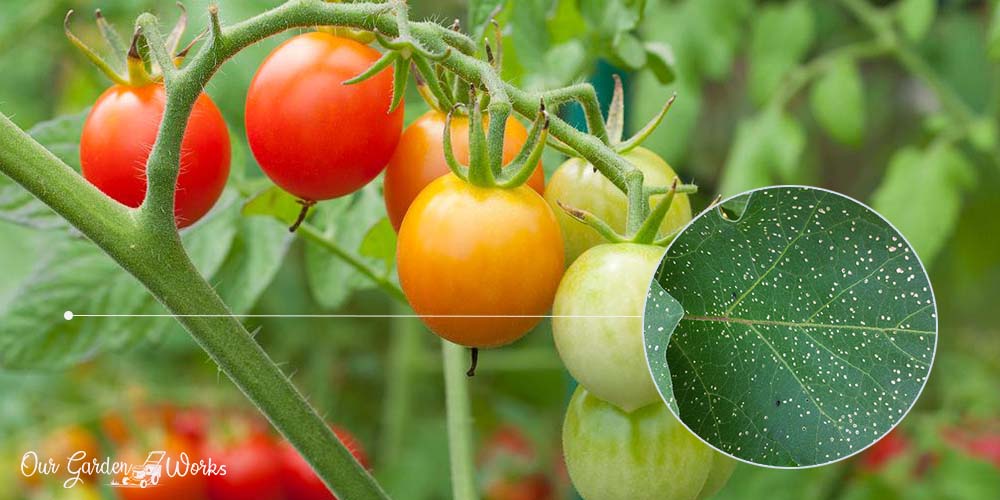Tomato plants are often a magnet of pests and diseases. Small holes in tomato leaves are among the common dilemmas of tomato gardeners. Almost all common pests are raving on tomato plants due to their juiciness and distinct flavor.
In this post, we will share with you the top causes of the small holes in your tomatoes and how you can treat them.
By the way, we have already discussed the common Insect Infestation in Tomatoes in this post you may have in growing your tomatoes.
6 Common Causes Of Small Holes On Tomato Leaves
You can find out what causes the holes on your tomato leaves, by studying the hole patterns.
Here are the common culprits for damaging the leaves of your tomato plants.
#1 Fruitworms
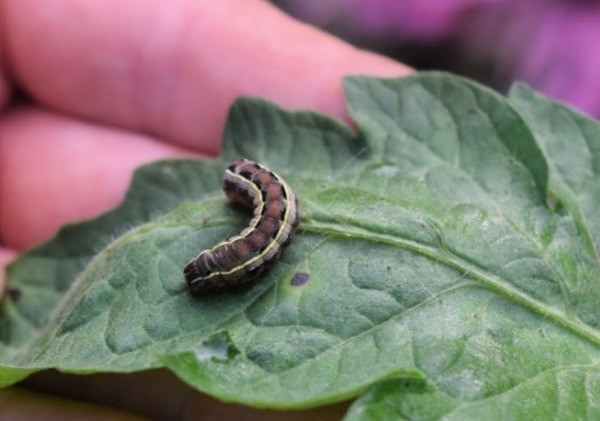
First, on our list are the brown caterpillars called fruitworms. They are also called cotton bollworms and corn earworms in some regions. They are known for damaging tomatoes through tunneling.
Fruitworms eat the leaves, stems, and fruit of tomatoes. When the fruits are still young, fruit worms munch on the leaves by boring small holes.
At first, you will not notice the small holes. However, as they keep feeding on the leaves, the holes become more obvious.
When the tomato fruits start to develop, fruitworms will start boring holes and feed on the internal parts of the tomatoes.
What’s worse is they leave their wastes inside the tomato and leave it rotting. Tomatoes damaged with fruitworms are no longer edible.
Other signs of fruit worm infestation:
To confirm that you are dealing with fruit worm infestation, here are other signs that you can check:
- Black pinhead-sized eggs over and under the leaves. Adult fruitworms lay white eggs on the leaves that turn black after 24 hours. After 10 days the eggs will hatch and turn into white larvae. As they develop, they become green or brown.
- They start feeding on stems causing black holes and creating tunnels. This feeding pattern is called tunneling which fruitworms are known for.
Fruitworms are sneaky and can move from one fruit to another to hide from potential predators in the area.
So, if you keep seeing holes in your tomato fruits, chances are, the worms are inside one of the fruits or the stem. They stay in the larval stage for 14 to 21 days.
How to protect your tomatoes against fruitworms?
Fruitworm damage can turn your long-awaited tomato fruits into inedible wastes in days. To protect your tomatoes, here are some steps that you can take:
- Keep predator insects around: Nature has its ways of dealing with pests. You can let the fruitworms be a delicious snack for the following insects:
- Parasitic wasps
- Big-eyed bugs
- Use Bacillus thuringiensis: One of the environment-friendly that you can use against fruitworms is using Bt or Bacillus Thuringiensis. Bt is a bacteria found in the soil that paralyzes the digestive system of insects and lets them die from starvation. However, the fruit worm must consume Bt to make it work against them. Otherwise, they will be propagating in your tomato plants.
- Get tougher insecticidal control through Spinosad: Spinosad can also be used in treating larvae and caterpillars. However, you must be careful in using it since it can kill beneficial insects in your gardens like bees and ladybugs.
- Planting strategies: Since fruitworms also feed on corn, you can avoid planting tomatoes next to corn.
#2 Flea Beetles
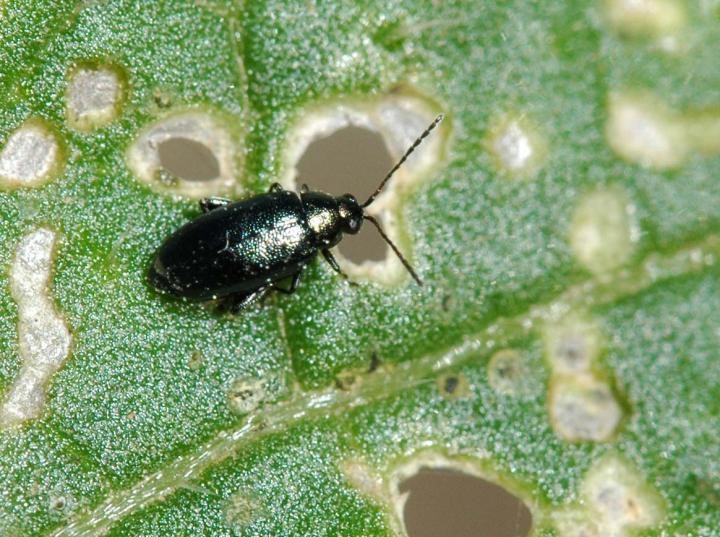
Another possible culprit of the holes on your tomato leaves is the jumpy flea beetles. The small type of beetles that feeds on the leaves and stems of tomato plants. You can easily identify them through their irregularly-shaped feeding trail. Some of the characteristics of flea beetles include:
- Color: striped, black, bronze, bluish, brown, or metallic gray
- They have long black legs for jumping
Flea beetles can overwinter in the soil and stay on dried leaves and wooded areas.
Sadly, they lay their eggs not only on the leaves but also on the roots and stems of plants. As soon as the eggs hatch and develop into larvae they can feed on the roots of tomato seedlings.
Aside from tomatoes, they can also create holes on the leaves of their vegetables, such as:
- Squash
- Beans
- Corn
- Sunflowers
- Lettuce
- Potatoes
Flea beetles emerge during spring. During that time ramp up on your preventive insect control to prevent further flea beetle damage.
In summer, most tomato plants are strong enough to withstand pest damage unless it becomes a heavy infestation. If the number of flea beetles is not increasing, you can let them naturally stop feeding on your tomato leaves during summer.
Pro tip: Tomato transplants are more resistant to flea beetle damage than those grown from seeds. Try to apply insecticide immediately if your tomatoes are grown from seeds to prevent the infestation from killing your plant.
How to control flea beetle infestation in your tomato plants?
Since flea beetles can grow and develop anywhere around your garden, here are some tips that you can try to control them:
- Handpick visible flea beetles in your tomato plants. Nothing beats the physical removal of these pesky pests in your crops.
- Use the yellow sticky traps in your garden to trap the flea beetles and control them as early as possible.
- Use an insecticide as soon as you spot one to three flea beetles in your garden. Best insecticides for flea beetles include Sevin Killer concentrate or pyrethrin for organic gardeners.
- To control overwintering flea beetles, tilling the soil; after the first frost can expose them to the cold temperature and die.
- Grow plant varieties that flea beetles hate such as basil and catnip.
- You can also attract the predators of flea beetles such as: Braconid wasps, Tachinid flies, Toads, Parasitic wasps
#3 Aphids

Aphids are by far the most common pests in tomatoes. They bore microscopic holes on the leaves and stems of tomato plants. They extract sweet sap for the leaves that can drain the leaves and cause yellowing of leaves.
These microscopic holes on tomato leaves affect the photosynthesis in tomatoes and affect the health of your plants. The most obvious signs of an aphid infestation include:
- Small white, black, or green insects and eggs on the underside of the tomato leaves.
- Black spots and yellowing of leaves due to the excessive feeding of aphids
- Ants are also starting to visit your tomato plants. They feed on the honeydew that aphids extract from your plants. Do not try to kill the ants as they do not directly harm your tomatoes.
Aside from damaging your plants, aphids can also become a carrier of plant diseases to your tomato plants.
So, as soon as you see subtle signs, it is best to control them before the infestation gets worse. Infestation starts when the winged aphids find your tomato plants as the new host.
The winged aphids bring with them their young and leave on the new host to propagate. It takes 7 to 10 days for them to mature and reproduce with 40 to 60 nymphs after offspring from every female aphid. They can increase rapidly and overwhelm your plants if they are not strong enough to withstand heavy infestations.
How to control aphid infestation on tomato leaves?
Aphids are soft-bodied insects that can easily increase in number if not controlled early. Here are some control measures that you can try:
- Dish soap solution: Compared to other pest infestations, aphids are easier to control since they can be treated with household ingredients you have at home. Here’s how you make your is dish soap solution:
How to make a homemade dish soap solution:
- Mix 1 part of water with 2 teaspoons of castile soap and a few drops of oil
- Shake it well and transfer it to a spray bottle.
- Apply it on your plants and use a clean cloth to wipe the top and underside of the leaves.
- Neem oil: Neem oil is the most organic insecticide that you can use on the aphid infestation in your plants. You just have to make sure that you apply it late in the afternoon or early in the morning to avoid burning the leaves of your plants.
- Handpicking: If there are only a few visible aphids on the leaves, the easiest way to get rid of them is to pick them up and deposit them in a bucket of soapy water.
- Predator insects: Lacewings and ladybugs are the insects that you can rely on to help you control the aphids on your plants.
#4 Slugs
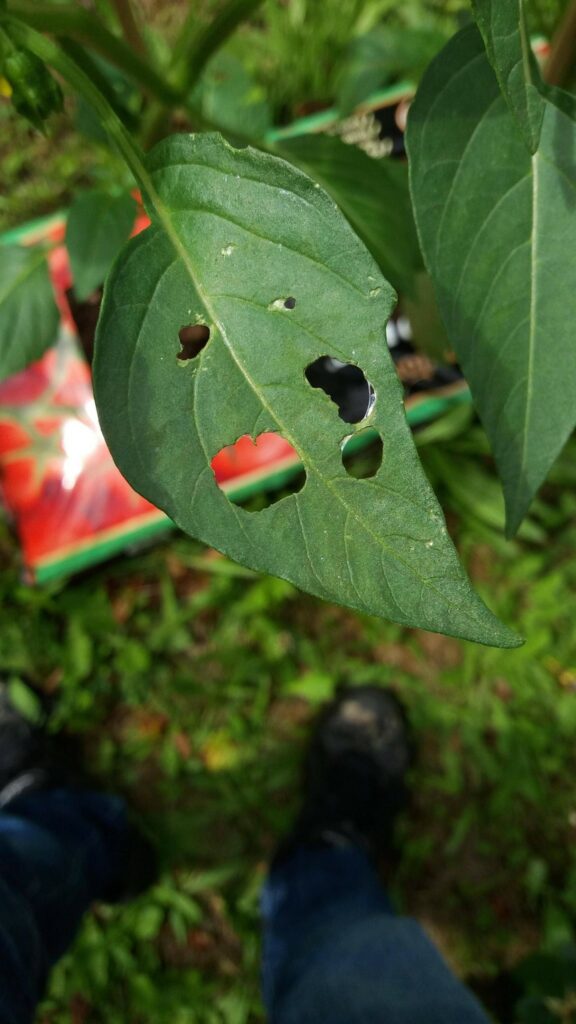
Low-lying tomatoes that touch the soil are most likely to be damaged by slugs. Slugs can chew on the stems and fruit of your tomatoes. They can hide in the bushes and nooks and crannies around your garden during the day and attack your plants at night.
Slugs love the cool and wet weather. They are notorious plant-eater and can run over your tomato seedlings by storm. As hermaphrodites, they can reproduce 400 round eggs alone every year. Their eating pattern is from the edges of the leaves and seedlings are down to eat up to their stem.
Other key signs that slugs are eating up the leaves of your tomato plants are the shiny mucus trails that they leave behind. Slugs are most active in spring and summer. Their feeding pattern is irregular ragged holes and in worst cases, they can defoliate your tomatoes.
How to protect your tomatoes from slugs?
Slugs are soil-borne pests that can take over your garden in a split second. They produce a lot of eggs without mating and are pretty good at hiding during the day.
Here are some ways to control slugs in your garden:
- Keep your tomatoes elevated: Use stakes to keep your tomatoes off the ground. The leaves and fruits must not touch even the mulch itself. Doing so not only keeps your tomatoes safe from slug damage but also with soil-borne fungal diseases.
- Handpick all the slugs that you see in the soil: Picking them up provides an instant decrease in the number of slugs in your garden. You can use a tweezer to pick the small slugs and snails in the soil.
- Set up barriers: You can surround your tomato plants with diatomaceous earth, salt, or sawdust to keep the slugs away.
- Refrain from using loose mulch: If you have slug problems in your area, mulching may not be a good idea for your tomatoes as slugs can easily hide from it.
- Water your plants in the morning: Slugs love wet conditions. Watering your plants in the afternoon leaves the soil moist at night and encourages more slugs in the area.
#5 Cutworms
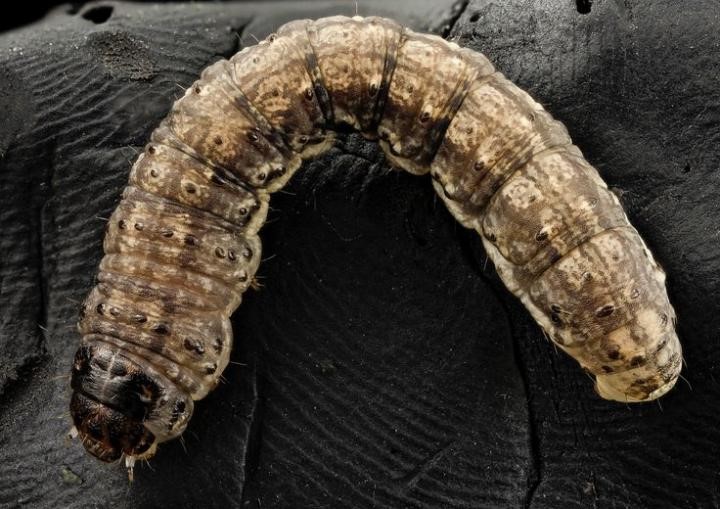
Cutworms are among the common pests in tomatoes. Along with other pests, they are prevalent during spring and summer. They got their name cutworms since they can cut up to one inch of the base of the plant. They damage your plants by feeding on the leaves and digging holes in your long-awaited tomato fruits.
Cutworms are usually gray or brown and grow up to 2 inches long. The common behavior of these caterpillars is hiding and living in the soil during the day and starting feeding at night. Seedling tomatoes are more prone to cutworm damage than mature and fully developed tomatoes.
To help you identify a cutworm, here are its other features and behavior:
- Not hairy as other types of caterpillars.
- Curl into C shape most of the time unless they are feeding.
- Can overwinter in the soil
- Curl around the stem they are feeding on
Other signs of cutworm damage to look out for:
(1) In the morning, check for plants that are cut off near the soil surface or when your plants are starting to wilt. If you see broken stems on the ground, you are most likely dealing with cutworms.
Pro tip: One way to confirm if your cutworm infestation is by checking the soil surface. Grab a clump of soil in your hands and see if they are cutworms curling when you touch them.
(2) Check for any cut stems of pepper and celery and other crops near your tomatoes.
Pro tip: Cutworms are easy to control on their larval stage. For tomatoes, you have to keep on looking out for cutworm infestation until the day of harvest.
How to control cutworms in your tomatoes?
In dealing with pests like cutworms, pesticides are just a part of the solution. You can also change the soil environment around your crops to prevent them from damaging your tomatoes.
Here are some ways you can discourage cutworms from feeding off your plants:
- Place dry soil around tomatoes to discourage cutworms from crawling around your tomatoes.
- Always clean the dried leaves and other plant debris around your tomatoes to avoid creating a suitable place for cutworms to hide and propagate during the day.
- Till your garden before and after the growing season to expose the hidden cutworms in the soil. Doing so will also kill their pupae and young larvae in the soil.
- Green manure may encourage the cutworm population in your garden. You may opt for a compost as an alternative to prevent them from laying eggs on the soil surface.
- You may also place aluminum foil and cardboard barriers around your tomatoes to prevent them from feeding off the stems, leaves, and fruits of tomatoes.
- If you have a heavy infestation of cutworms, you may use biological insecticides like Bt or Bacillus Thuringiensis to control their numbers. If all else fails, you may also use pyrethrin like PyGanic Pyrethrin Concentrate.
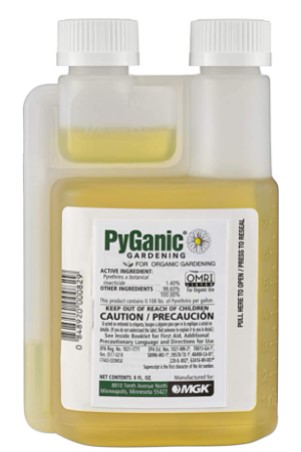
#6 Tomato Hornworms
Tomato hornworms are another type of notorious leaf-eaters in tomatoes. Their damages on tomato leaves are large holes that look chewed. In the worst cases, they can defoliate your tomato plants completely.
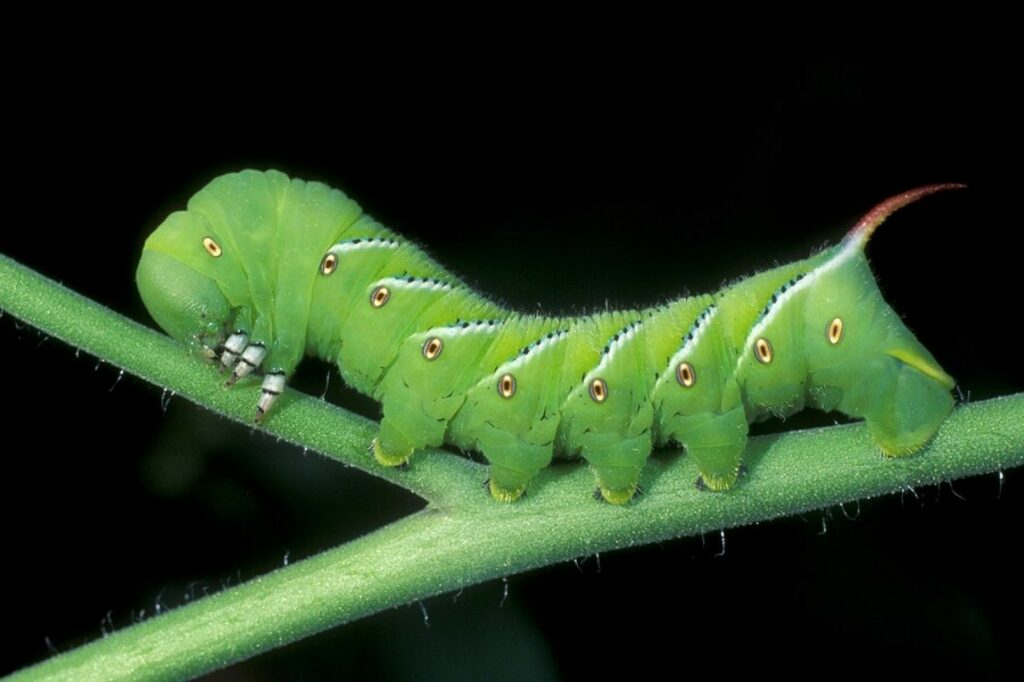
Tomato hornworms usually attack tomato plants from July to September. They can grow up to 4 inches long and have a light green color that makes them almost hard to find on the stems and the undersides of the leaves of your tomato plants. They have distinct white and black markings on their body that makes them recognizable among other types of caterpillars.
Like cutworms, tomato hornworms hate the humid environment. They stay on the shaded parts of the plant until sundown and start feeding at night till dawn. The key indicators that the holes on your tomatoes are caused by tomato hornworms include:
- Wilting leaves
- Stems with no leaves
- Frass or caterpillar poop on the lower leaves
At the end of their development, they become large moths with heavy bodies. Their wings have a span of 4 to 5 inches. The easiest control for these big caterpillars is by handpicking.
Other methods to control tomato hornworms in your garden:
Hornworms may be hard to notice but there are several ways to keep them out of your garden. These include:
(1) Bacillus Thuringiensis: Insecticides may control some types of caterpillars but they are not as effective as Bacillus Thuringiensis. One of the best Bt solutions that most gardeners trust is Safer Brand Caterpillar Killer II Concentrate.
(2) Spinosad: If you have a heavy hornworm infestation, using chemical insecticides won’t hurt. Spinosad is among the highly-effective chemical pesticides for a variety of caterpillars and other insects. Among which is the Monterey Garden Spray Spinosad Concentrate.
Final Thoughts
Almost all of the common pests in plants love to feed on tomatoes. Their juicy fruits and leaves make them a perfect snack for beetles, caterpillars, and soft-bodied insects like aphids.
So, make sure to apply preventive pest control every month to make sure that you’ll have a bounty harvest this growing season.
We hope that this post helped you identify what is causing the small holes in your tomato leaves.
If you find this post informative, share it with your friends and let them find the pests feeding on their crops.
Did you find the stubborn pest lingering on your tomatoes? Let us know in the comments below.
